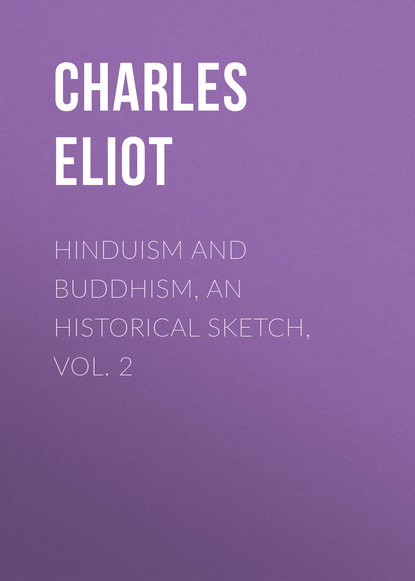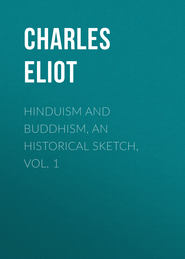По всем вопросам обращайтесь на: info@litportal.ru
(©) 2003-2024.
✖
Hinduism and Buddhism, An Historical Sketch, Vol. 2
Автор
Год написания книги
2018
Настройки чтения
Размер шрифта
Высота строк
Поля
See above, p. 207 ff.
775
The same distinction occurs in the works of Meister Eckhart († 1327 A.D.) who in many ways approximates to Indian thought, both Buddhist and Vedântist. He makes a distinction between the Godhead and God. The Godhead is the revealer but unrevealed: it is described as "wordless" (Yâjnavalkya's neti, neti), "the nameless nothing," "the immoveable rest." But God is the manifestation of the Godhead, the uttered word. "All that is in the Godhead is one. Therefore we can say nothing. He is above all names, above all nature. God works, so doeth not the Godhead. Therein are they distinguished, in working and in not working. The end of all things is the hidden darkness of the eternal Godhead, unknown and never to be known." (Quoted by Rufus Jones, Studies in Mystical Religion, p. 225.) It may be doubted if Śankara's distinction between the Higher and Lower Brahman is to be found in the Upanishads but it is probably the best means of harmonizing the discrepancies in those works which Indian theologians feel bound to explain away.
776
Vedânta sûtras, II. 1. 32-3, and Śaṅkara's commentary, S.B.E. vol. XXXIV. pp. 356-7. Râmânuja holds a similar view and it is very common in India, e.g. Vishṇu Pur. I. chap. 2.
777
See too a remarkable passage in his comment on Brahma-sûtras, II. 1. 23. "As soon as the consciousness of non-difference arises in us, the transmigratory state of the individual soul and the creative quality of Brahman vanish at once, the whole phenomenon of plurality which springs from wrong knowledge being sublated by perfect knowledge and what becomes then of the creation and the faults of not doing what is beneficial and the like?"
778
Although Śaṅkara's commentary is a piece of severe ratiocination, especially in its controversial parts, yet he holds that the knowledge of Brahman depends not on reasoning but on scripture and intuition. "The presentation before the mind of the Highest Self is effected by meditation and devotion." Brah. Sut. III. 2. 24. See too his comments on I. 1. 2 and II. 1. 11.
779
See Sukhtankar, Teachings of Vedânta according to Râmânuja, pp. 17-19. Walleser, Der aeltere Vedânta, and De la Vallée Poussin in J.R.A.S. 1910, p. 129.
780
This term is generally rendered by qualified, that is not absolute, Monism. But South Indian scholars give a slightly different explanation and maintain that it is equivalent to Viśishṭayor advaitam or the identity of the two qualified (viśishṭa) conditions of Brahman. Brahman is qualified by cit and acit, souls and matter, which stand to him in the relation of attributes. The two conditions are Kâryâvasthâ or period of cosmic manifestation in which cit and acit are manifest and Karaṇâvasthâ or period of cosmic dissolution, when they exist only in a subtle state within Brahman. These two conditions are not different (advaitam). See Srinivas Iyengar, J.R.A.S. 1912, p. 1073 and also Sri Râmânujâcárya: His Philosophy by Rajagopalacharyar.
781
Compare the phrase of Keats in a letter quoted by Bosanquet, Gifford Lectures for 1912, p. 66. "As various as the lives of men are, so various become their souls and thus does God make individual beings, souls, identical souls of the sparks of his own essence."
782
This tenet is justified by Bṛihad Aran. Up. III. 3 ff. which is a great text for Râmânuja's school. "He who dwells in the earth (water, etc.) and within the earth (or, is different from the earth) whom the earth knows not, whose body the earth is, who rules the earth within, he is thyself, the ruler within, the immortal."
783
Bhag.-gîtâ, XV. 16, 17.
784
The two doctrines are called Vivartavâda and Pariṇâmavâda.
785
These are only the more subtle tattvas. There are also 60 gross ones. See for the whole subject Schomerus Der Çaiva-Siddhânta, p. 129.
786
It also finds expression in myths about the division of the deity into male and female halves, the cosmic egg, etc., which are found in all strata of Indian literature.
787
An account of tantric cosmology can be found in Avalon, Mahân. Tantra, pp xix-xxxi. See also Avalon, Prapancasâra Tantra, pp. 5 ff.; Srinivâsa Iyengar, Indian Philosophy, pp. 143 and 295 ff.; Bhandarkar, Vaishṇ. and Śaivism, pp. 145 ff.
788
Sarva-darśana-saṇgraha, chap. IX. For this doctrine in China see Wieger Histoire des Croyances religieuses en Chine, p. 411.
789
See Yule's Marco Polo, II. pp. 365, 369.
790
See Rhys Davids' note in his Dialogues of the Buddha on Dîgha Nikâya, Sutta V. pp. 166 ff. He seems to show that Lokâyata meant originally natural philosophy as a part of a Brahman's education and only gradually acquired a bad meaning. The Arthasâstra also recommends the Sânkhya, Yoga and Lokâyata systems.
791
Maitr. Up. VII. 8.
792
See also Suali in Muséon, 1908, pp. 277 ff. and the article Materialism (Indian) in E.R.E. For another instance of ancient materialism see the views of Pâyâsi set forth in Dig. Nik. XXIII. The Bṛihad Ar. Up. III. 2. 13 implies that the idea of body and spirit being disintegrated at death was known though perhaps not relished.
793
Translation by Shea and Troyer, vol. II. pp. 201-2.
794
Sanskrit Manuscripts in the Adyar Library, 1908, pp. 300-1.






